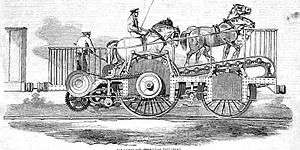Impulsoria
The Impulsoria was a locomotive constructed in 1850 that was powered by horses on a treadmill following a design by Clemente Masserano. The locomotive undertook trials in London in 1850 and was exhibited at The Great Exhibition in 1851.
| Impulsoria | |||||||||
|---|---|---|---|---|---|---|---|---|---|
 Impulsoria in 1850. | |||||||||
| |||||||||
| |||||||||
| |||||||||
| |||||||||
Description
The invention of a successful mobile treadmill powered locomotive was made by Clemente Masserano from Pignerol in Italy. The idea was not new, but previous attempts in England, France and Spain had been unsuccessful.[1] Using Messano's designs it was built in Italy and transported to England.[1] A syndicate was formed and it was trialled at the Nine Elms terminus of the South Western Railway line in London where it successfully completed a hill climb. The trials were supported by the directors of the South Western Railway and assisted by their Chief Engineer John Gooch. The device was said to be much cheaper to run than a steam locomotive. The device allowed a steam locomotive to be replaced by this vehicle, which used the power of two or four horses that had to walk up a treadmill. The treadmill was called a pedivella by Masserano.[1] The power was transferred to the wheels by chains[2] and a gearbox that allowed it to climb. It was said to be able to pull 30 wagons up an incline and could be used with two or four horses.[3]
The gear box allowed the horses to always walk at their best speed whilst the vehicle could then have a range of speeds and torques. Because of the gears, the top speed was not limited to the top speed of the horses. The gearbox allowed the horses to drive the vehicle in forward as well as reverse directions, and it was also possible to disengage the drive so that the vehicle could stop whilst the horses continued to walk up the treadmill. The vehicle travelled at 7 mph (11 km/h) during the trials, but it was thought that a final version would reach 15 to 20 mph (24 to 32 km/h) and would outrun a steam engine.[1]
Cost and efficiency
The efficiency of the device was compared favourably with existing steam locomotives, which were thought to waste too much energy. The cost of operating the Impulsoria was estimated at two shillings per day per horse. During that eight-hour day it was estimated that the horses could propel Impulsoria eight times over a thirty-mile route.[1]
Exhibition
An Italian Professor of Philosophy, Dr Andrea Crestadoro, improved the design of this unusual device (and later took out patents in 1852).[4] Following his improvements Crestadoro exhibited it at The Great Exhibition held in the Crystal Palace in 1851.[4] After this date Crestadoro took an interest in bibliography and became a librarian in Manchester. The final tale of Impulsoria may be in Germany where a device of that name was exhibited in 1853. This device was said to be the property of a person named Steinheil.[5]
References
- The Engineer and machinist. 1850. p. 184.
- "Can you help with information about inventor's masterpiece?". This is Somerset. 23 February 2010. Retrieved 18 December 2010.
- Ellis, Cuthbert (1956). The South Western Railway: its mechanical history and background, 1838-1922. Allen and Unwin. p. 256.
- "The Impulsoria". svsfilm. Retrieved 18 December 2010.
- Day, John R. (1960). More Unusual Railways. p. 33. Retrieved 19 December 2010.